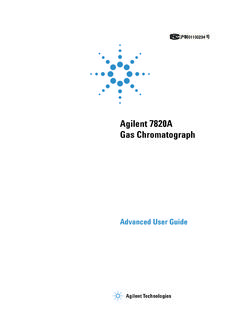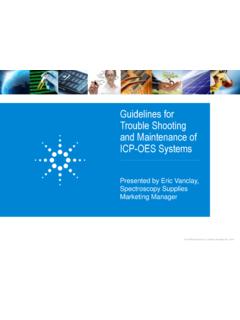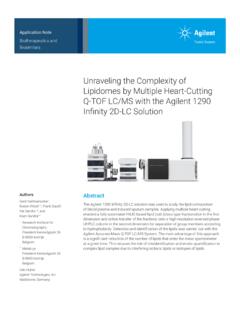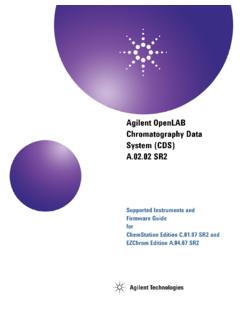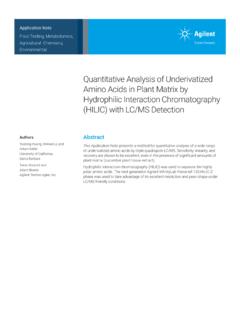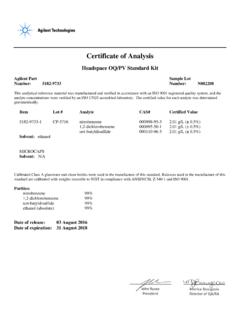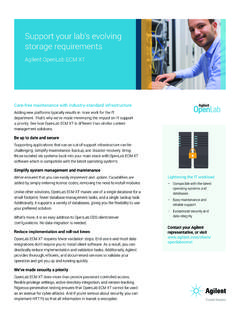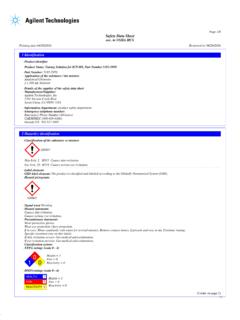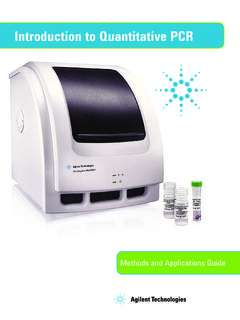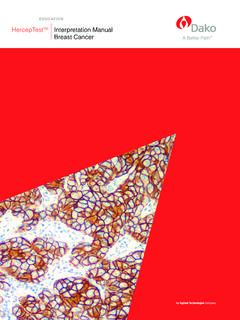Transcription of Agilent 5900 ICP-OES brochure
1 Agilent 5900 ICP-OESThe smart way to high productivity and low cost of ownership2 Supercharge Your Lab s BusinessThe smart Agilent 5900 is designed to get the right answer faster than any other instrument, with the lowest cost per sample. Measuring a sample per minute with reliable results and low argon consumption maximizes return on investment. 3 Minimize ownership costs1. Argon consumption is calculated from argon flow rates multiplied by duration of flow. The analysis speed and gas consumption figures are compared to competitive systems, based on published application data. Reduce cost-per-sampleArgon use is a major contributor to the overall operating cost of an ICP-OES , with analysis time, argon gas flow rate, and purity requirements directly affecting it.
2 The 5900 measures samples in half the time and has the lowest argon consumption per sample1 of any ICP-OES instrument. An innovative, smaller Freeform optical design improves analytical performance and reduces gas purge times by half. Compatible with lower cost purity Ar gas, further reducing gas costs by 50%.Minimize sample remeasurement and downtimeReduce unexpected instrument downtime and remeasuring of samples by knowing more about your analysis. The Agilent 5900 has an ecosystem of embedded sensors and powerful processors, with smart algorithms and diagnostics. These smart features provide deep sample and operational insight, giving you greater confidence in the final result.
3 The IntelliQuant software function quickly screens samples, determining the approximate concentration of up to 70 elements . It automatically identifies unexpected spectral interferences and recommends alternative wavelengths that are free from interference. Instrument uptime and performance are maximized with the use of smart health tracking diagnostics that monitor and alert the operator about instrument maintenance costsReduce unnecessary service call-outs and optimize maintenance schedules, based on actual instrument usage, rather than elapsed time. Up to a third of all service call-outs are linked to problems the operator could have solved themselves, with the right guidance Data-driven, usage-based maintenance schedules allow you to perform the right amount of maintenance.
4 Usage-based maintenance ensures peak instrument performance and keeps service costs low. Reduce consumable replacement costs by ensuring sample introduction components and high-wear items are cleaned and replaced only when reduce your argon consumption1 The 5900 ICP-OES has the lowest argon consumption per sample of any ICP-OES instrument. 20 L27 L> 40 L5900 SVDV5800 VDVC ompetitor s instruments4 Axial lightVertical torch and plasmaDichroic Spectral Combiner (DSC)Radial lightTo detectorRun More Samples at Lower Cost for Maximum Revenue PotentialFast, accurate results in a single measurement Conventional dual view ICP-OES systems require you to set up a series of sequential measurements by selecting which elements are measured in axial mode, and which are measured in radial mode.
5 This takes time, making sample throughput 5900 ICP-OES needs only a single measurement per sample we call this Synchronous Vertical Dual View (SVDV). A unique optical component, the Dichroic Spectral Combiner (DSC), allows both the axial and radial views of the plasma to be captured in one reading. This delivers accurate results in the shortest possible analysis time = lower gas consumption Many people fall victim to misleading claims that suggest flow rate directly correlates with gas consumption. While flow rate is an important factor, it can t be considered on its own. Analysis time is also critical.
6 For example, if you halve your analysis time, you can reduce your argon use by nearly 40%, even if your argon flow rate is 20% higher. This graph shows how the consumption of argon changes with flow rate and measurement time, for different sample batch sizes. 5 Reduce Downtime with a Smarter ICP-OESLess downtime means more time to run samples and more revenue for your labMore uptime means more revenueMaintain peak performance, maximize instrument uptime, and avoid problems before they occur. The smart diagnostics built into the 5900 monitor and alert you when maintenance is required. Traffic light color-coding of the counters visually shows which maintenance activities should be done immediately, and which can early maintenance feedback system reduces downtime and repair costs by scheduling routine maintenance of components based on actual usage, rather than at set time Neb Alert function provides real-time warning on unpredictable events such as nebulizer leaks and blockages.
7 These alerts enable quick response and less wasted time when analyzing samples with high peripherals such as autosamplers and other accessories can be monitored. Alerts are issued when smart sensor thresholds are exceeded. 6It s like having QC on every sampleIf your results are too high, it could be due to a spectral interference from another element. Results that are too low could be due to chemistry problems. IntelliQuant uses data analytics to automatically identify spectral overlaps that can lead to false-positive results, and recommends the emission wavelength that will give the most accurate example on the right shows the measurement of cadmium at nm.
8 The measured emission (blue line) has been erroneously increased by the presence of an emission from arsenic (red line). IntelliQuant will flag this wavelength as being problematic using a star ranking feature (shown below) to make it easy for the user to select the right wavelength to report on. IntelliQuant puts the power of an experienced analyst inside your instrument and only Agilent has itIntelliQuant captures data from the entire wavelength range as each sample is measured, then uses this broader view to calculate the approximate concentration of up to 70 elements in a sample. By collecting more than just the data at the wavelengths nominated, IntelliQuant sees spectral interferences and provides you with recommendations to ensure you get the right answers every time.
9 Running unknown or atypical samples? Put IntelliQuant to work, and ease your method development, troubleshooting, and sample screening insight into what s in your sample and how to best measure itLearn More About Your ** ** * * ** *Analyte: Cd( )Confidence: moderateInterference: As( )Confidence: spectrumIntensity100002000030000400000-4 000interferentWavelength (nm)IntelliQuant Star ranking output for Cd. A five-star ranking with green check mark indicates Cd 214 wavelength to be the best. The red question mark indicates there is an issue on Cd 228, and the pop-up tip indicates the Cd 228 result has only moderate confidence as it has a strong arsenic interference.
10 7 Fast sample screening IntelliQuant Screening can be used to determine the approximate concentration of up to 70 elements in a sample within seconds. Ideal for: Method development assistance for unknown samples Trend analysis for batches of samples measured routinely, such as soils, engine oils, or plating baths Results can be presented in a range of smart views for users to quickly review the constituents of a sample (pie chart view shown below). K (4 4 .1%)Ca ( )P (17. 4%)Na ( )S ( )Mg ( )Fe ( )Other ( )Flagging outlying resultsAn outlier alert highlights results that exceed a nominated range or don t pass a test.
